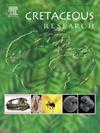Paleoclimate variation during the Cretaceous revealed by geochemical and mineralogical analyses from continental sediments in northern Vietnam
IF 1.7
3区 地球科学
Q1 GEOLOGY
引用次数: 0
Abstract
Severe aridification has been recognized in low-latitude areas of Southeast Asia during the mid-Cretaceous; however, previous studies mainly focused on continental interior basins. Here, we investigate Cretaceous continental sediments from northern Vietnam, located in the Southeast Asian continental margin, where a precise study has not been conducted. The geochemical and mineralogical characteristics of mudstones collected from the Ban Hang and Yen Chau formations revealed fluctuations in climate conditions in northern Vietnam, including a slight humidification from the Early to mid-Cretaceous and aridification in the Late Cretaceous. Northern Vietnam is considered to have experienced a temperate semi-arid climate in the Early Cretaceous but shifted to a hot and sub-humid environment in the mid-Cretaceous and then returned to arid conditions in the late Period. The results indicate that the coastal area of Southeast Asia was more humid than the inland due to its proximity to the proto-Pacific Ocean. We also detected an increase in humidity in the coastal area during the mid-Cretaceous, contrasting with the inland regions where extreme aridification progressed. This contrasting paleoclimate regime was probably established by the isolation of coastal and inland areas by the tectonic re-configuration of the Southeast Asian continent. During the Cretaceous, closure of the Meso-Tethys Ocean and collisional tectonics generated a coastal mountain range, which caused the orogenic rain-shadow effects, i.e., increased precipitation in the coastal area and intensified desertification in the inland area. The present contribution indicates that the Cretaceous paleoclimate conditions in Southeast Asia were primarily constrained by the regional geographical background rather than the global climate system.
越南北部大陆沉积物地球化学和矿物学分析揭示的白垩纪古气候变化
在白垩纪中期,东南亚低纬度地区发生了严重的干旱化;然而,以往的研究主要集中在大陆内部盆地。在这里,我们研究了位于东南亚大陆边缘的越南北部的白垩纪大陆沉积物,在那里没有进行过精确的研究。banhang组和Yen Chau组泥岩的地球化学和矿物学特征揭示了越南北部气候条件的波动,包括早白垩世至中白垩世的轻微湿润和晚白垩世的干旱化。越南北部被认为在白垩纪早期经历了温带半干旱气候,但在白垩纪中期转向炎热和半湿润的环境,然后在白垩纪晚期回到干旱条件。结果表明,东南亚沿海地区由于靠近原太平洋,湿润程度高于内陆地区。我们还发现,在白垩纪中期,沿海地区的湿度有所增加,与内陆地区的极端干旱化形成对比。这种对比鲜明的古气候体系可能是由于东南亚大陆的构造重构使沿海地区与内陆地区分离而形成的。在白垩纪,中特提斯洋的闭合和碰撞构造形成了沿海山脉,造成了造山雨影效应,即沿海地区降水增加,内陆地区沙漠化加剧。目前的研究表明,东南亚白垩纪古气候条件主要受区域地理背景的制约,而不是全球气候系统的制约。
本文章由计算机程序翻译,如有差异,请以英文原文为准。
求助全文
约1分钟内获得全文
求助全文
来源期刊

Cretaceous Research
地学-地质学
CiteScore
4.10
自引率
19.00%
发文量
235
审稿时长
12 weeks
期刊介绍:
Cretaceous Research provides a forum for the rapid publication of research on all aspects of the Cretaceous Period, including its boundaries with the Jurassic and Palaeogene. Authoritative papers reporting detailed investigations of Cretaceous stratigraphy and palaeontology, studies of regional geology, and reviews of recently published books are complemented by short communications of significant new findings.
Papers submitted to Cretaceous Research should place the research in a broad context, with emphasis placed towards our better understanding of the Cretaceous, that are therefore of interest to the diverse, international readership of the journal. Full length papers that focus solely on a local theme or area will not be accepted for publication; authors of short communications are encouraged to discuss how their findings are of relevance to the Cretaceous on a broad scale.
Research Areas include:
• Regional geology
• Stratigraphy and palaeontology
• Palaeobiology
• Palaeobiogeography
• Palaeoceanography
• Palaeoclimatology
• Evolutionary Palaeoecology
• Geochronology
• Global events.
 求助内容:
求助内容: 应助结果提醒方式:
应助结果提醒方式:


